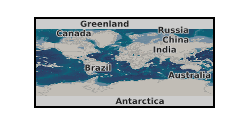Gondwana
Type of resources
Available actions
Topics
Keywords
Contact for the resource
Provided by
Years
Formats
Update frequencies
-

Zircon U-Pb isotope data are presented for eight plutonic rocks from the Masirah ophiolite and one plutonic rock from the Ra's Madrakah ophiolite (south east Oman). These data constrain the age of formation of the two ophiolite nappes exposed on Masirah Island (early Cretaceous), whereas two intrusions with younger ages (late Cretaceous) overlap with the proposed emplacement age of the ophiolite. The data cover two sites in the Masirah Lower Nappe, two sites in the Masirah Upper Nappe (on Masirah Island, off the SE coast of Oman) and one site on Ra's Madrakah (on the mainland of Oman). The interpretation and discussion of these data form part of a manuscript submitted to Geochemistry, Geophysics, Geosystems. Data collection was done using chemical abrasion isotope dilution thermal ionisation mass spectrometry (CA-ID-TIMS) at the NERC Isotope Geosciences Laboratories at the British geological Survey, supported by NERC Isotope Geosciences Facilities award IP-1919-0619. This work resulted from a PhD project funded by NERC GW4+ DTP grant NE/L002434/1.
-
The dataset consists of Ar-Ar isotope dating, field data, and selected geochemical analysis of igneous dykes and sills collected from Dronning Maud Land during the 2000-2001 field season. The aim was to measure ages of volcanism during flood basalt events in Dronning Maud Land associated with the breakup of Gondwana.The style and volume of magmatism varies between margins from large volume flood basalts such as the Parana or Deccan provinces to less volumetric margins such as the southern part of the South Atlantic. This case (Collaborative Awards in Science and Engineering) studentship was intended to provide support to study the evolution of the break-up of Africa and East Antarctica which occurred in the early Jurassic. An extended period of magmatism has been suggested for this margin associated with complex extensional tectonics. A combined geochronological / geochemical approach was used to understand the evolution of the crust and sub-continental lithospheric mantle during the break-up of one central portion of the Gondwana super continent.
-
Igneous dykes and sills were collected from Dronning Maud Land during the field season 2000-2001. The aim was to measure ages of volcanism during flood basalt events in Dronning Maud Land associated with the breakup of Gondwana. The style and volume of magmatism varies between margins from large volume flood basalts such as the Parana or Deccan provinces to less volumetric margins such as the southern part of the South Atlantic. This CASE (Collaborative Awards in Science and Engineering) studentship was intended to provide support to study the evolution of the break-up of Africa and East Antarctica which occurred in the early Jurassic. An extended period of magmatism has been suggested for this margin associated with complex extensional tectonics. A combined geochronological / geochemical approach was used to understand the evolution of the crust and sub-continental lithospheric mantle during the break-up of one central portion of the Gondwana super continent.
 NERC Data Catalogue Service
NERC Data Catalogue Service